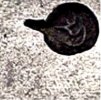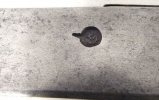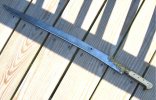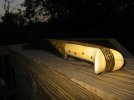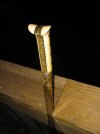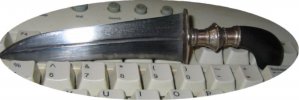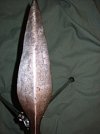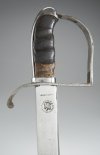Stacy E. Apelt - Bladesmith
ilmarinen - MODERATOR
Moderator
Knifemaker / Craftsman / Service Provider
- Joined
- Aug 20, 2004
- Messages
- 36,465
What are you chaps thoughts on doing a damasteel wakizashi ?
I received two batches of steel this week.
One batch was my order of meter long bars of Hitachi katana steel from Dictum ( white paper edge steel honsanmai with the sanmai sides in suminagashi). These will obviously become Japanese style swords and knives.
The other batch was four bars of Hugin pattern damasteel from a group buy with Ron Wilson.
When unwrapping the bars of damasteel ( 48" long bars) I had a thought about making a wakizashi in Damasteel. I know it is in no way traditional, but it sure would look stunning. A katana would be just too crazy, but a wak might work.
My concern is the likelihood of selling it. I have made more than one knife/sword that everyone picked up and said, "Wow, that is really something.", only to set it down and look at more normal ( and cheaper) knives/swords.. Some nice things just don't sell fast. The costly steel will obviously add a good bit to the price. I figure it will end up around $1200-1500 depending on the koshirae.
So,
Comments?
Thoughts?
Am I crazy to do this?( well, maybe we better not go there )
)
I received two batches of steel this week.
One batch was my order of meter long bars of Hitachi katana steel from Dictum ( white paper edge steel honsanmai with the sanmai sides in suminagashi). These will obviously become Japanese style swords and knives.
The other batch was four bars of Hugin pattern damasteel from a group buy with Ron Wilson.
When unwrapping the bars of damasteel ( 48" long bars) I had a thought about making a wakizashi in Damasteel. I know it is in no way traditional, but it sure would look stunning. A katana would be just too crazy, but a wak might work.
My concern is the likelihood of selling it. I have made more than one knife/sword that everyone picked up and said, "Wow, that is really something.", only to set it down and look at more normal ( and cheaper) knives/swords.. Some nice things just don't sell fast. The costly steel will obviously add a good bit to the price. I figure it will end up around $1200-1500 depending on the koshirae.
So,
Comments?
Thoughts?
Am I crazy to do this?( well, maybe we better not go there
Last edited:


